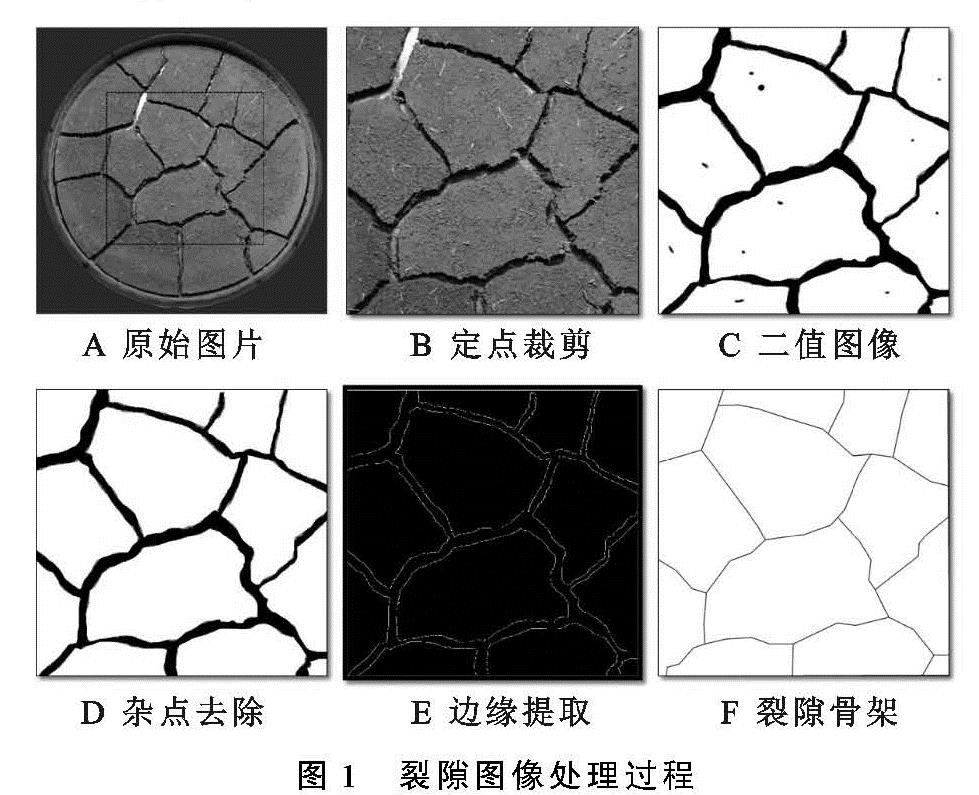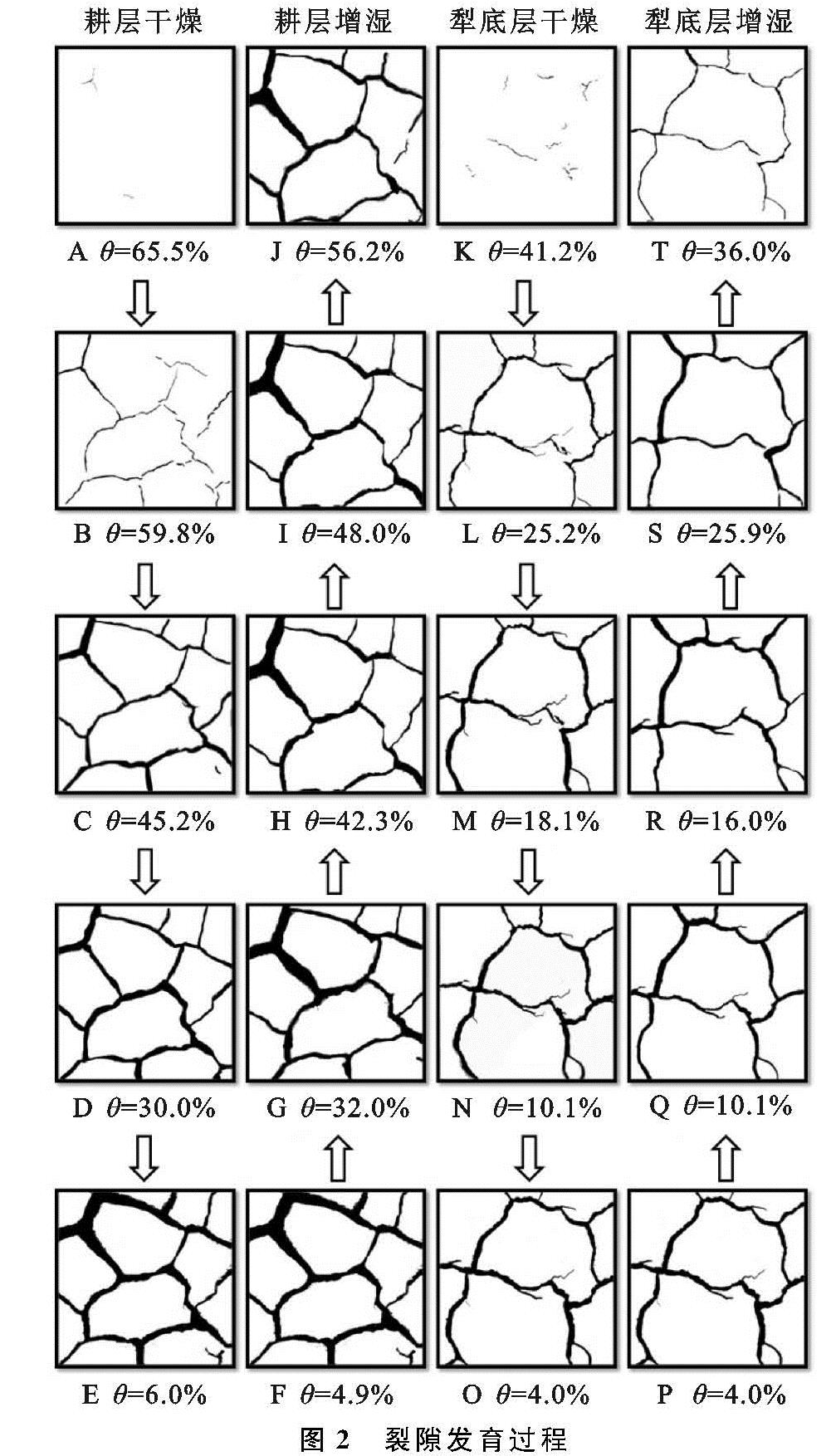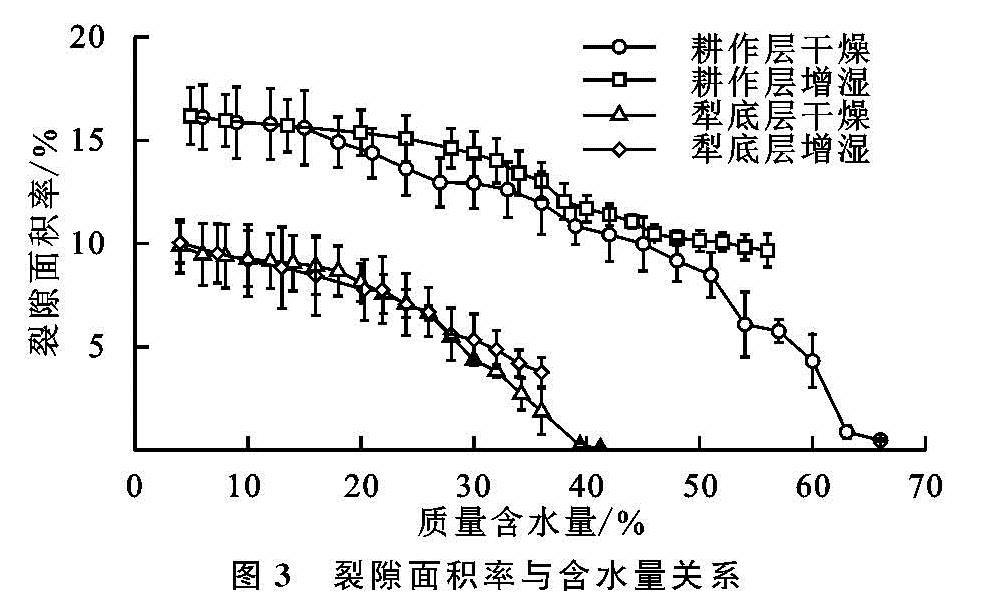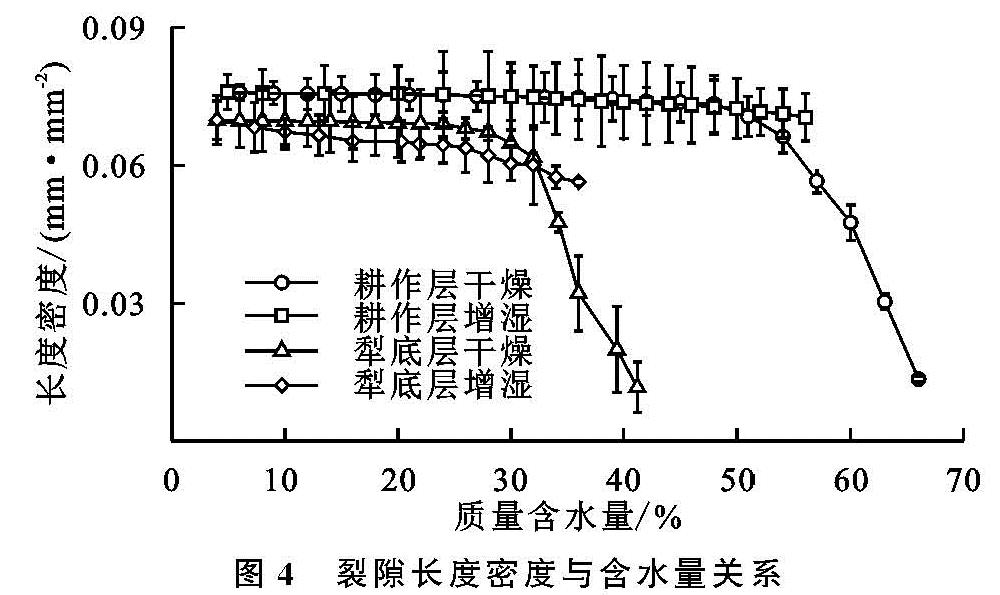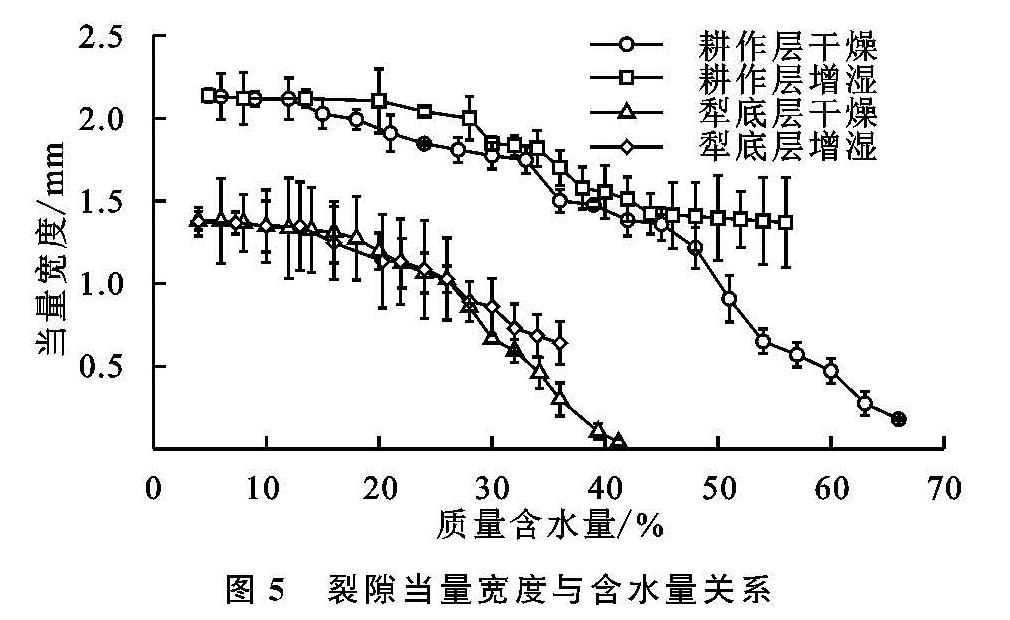2.1 土壤裂隙发育与闭合的动态过程
土壤裂隙的发育具有随机性,可分为一级裂隙与二级裂隙两类[17]。随着干湿交替进行,土壤裂隙发育过程见图2。
在耕作层土壤干燥过程中,裂隙的形成可分为4个阶段:(1)65.5%≥θ>59.8%,一级裂隙随机形成(θ为土壤质量含水量)(
图2A—B);(2)59.8%≥θ>30.0%,二级裂隙形成,裂隙不断拓宽(
图2B—D);(3)30.0%≥θ>6.0%,裂隙骨架结构保持稳定,仅宽度不断增加(
图2D—E);(4)6.0%≥θ,裂隙停止拓展。在耕作层土壤增湿过程中,裂隙的闭合可分为3个阶段:(1)42.3%≥θ≥4.9%,裂隙宽度逐渐减小,大量二级裂隙闭合,大量裂隙连接点消失(
图2F—H);(2)56.5%≥θ>42.3%,裂隙宽度继续减小但骨架结构保持稳定,少量裂隙逐渐闭合(
图2I—J);(3)θ>56.2%,裂隙停止闭合。
在犁底层土壤干燥过程中,裂隙的形成可分为3个阶段:(1)41.2%≥θ>25.2%,裂隙不断形成(包括一级裂隙和二级裂隙)(图2K—L);(2)25.2%≥θ>4.0%,裂隙宽度逐渐增加,裂隙骨架逐渐趋于稳定(图2M—O);(3)4.0%≥θ,裂隙停止拓展。
在犁底层土壤增湿过程中,裂隙的闭合可分为3个阶段:(1)16.0%≥θ≥4.0%,裂隙宽度逐渐减小(图2P—R);(2)36.0%≥θ>16.0%,裂隙连接点逐渐消失,裂隙宽度继续减小(图2S—T);(3)θ>36.0%,裂隙停止闭合。
2.2 开闭过程中裂隙面积率的变化
在干燥过程中,裂隙面积率随含水量的降低而逐渐增大,当达到一定程度后裂隙面积率不再发生变化(图3)。对于耕作层土壤,当其θ=65.5%时出现裂隙; 当65.5%>θ>15.1%时,裂隙面积率随θ的降低而迅速增长; 当15.1%≥θ时,裂隙基本稳定,随着θ的继续降低裂隙面积率变化极小; 当θ=6.0%时,裂隙面积率达最大值16.1%。对于犁底层土壤,当其θ=41.2%时出现裂隙; 当39.4%≥θ≥18.0%时,裂隙面积随θ的降低而迅速增长; 当17.0%≥θ时,随着θ的降低裂隙面积率变化极小,裂隙基本稳定; 当θ=4.0%时,裂隙面积率达最大值9.9%。
在增湿过程中,土壤裂隙随着含水量的不断增加而逐渐闭合,但增湿试验结束后仍不能完全闭合(
图3)。对于耕作层土壤,当24.0%≥θ≥4.9%时,裂隙面积率缓慢降低; 当46.1%≥θ>24.0%时,裂隙面积率降低速率加快; 当θ>46.1%时,土壤裂隙闭合速率再次减缓; 当θ=56.2%时,土壤裂隙不再闭合。对于犁底层土壤,其裂隙率随θ的增加稳定减小; 当θ=36.0%时,土壤裂隙不再发生变化。至土壤增湿试验结束,耕作层和犁底层土壤的裂隙率分别为9.7%,3.8%。在整个干湿交替试验过程中均表现为耕作层土壤裂隙面积率大于犁底层土壤,干缩裂隙完全形成后和增湿完成后耕作层土壤裂隙面积率约分别为犁底层的1.63倍、2.55倍。
2.3 开闭过程中裂隙长度密度的变化
在干燥过程中,裂隙长度密度先随着含水量的降低迅速增大,到达一定程度后裂隙长度密度维持稳定(图4)。对于耕作层土壤,其θ=65.5%时出现裂隙; 当65.5%>θ>47.2%时,长度密度快速增大; 当47.2%≥θ时,裂隙长度密度变化极小; 当θ=6.0%时,裂隙长度密度达到最大值(0.076 mm/mm2)不再发生变化。对于犁底层土壤,其θ=41.2%时出现裂隙; 当41.2%>θ>25.7%时,长度密度快速增长; 当25.7%≥θ时,裂隙长度密度变化极小; 当θ=4.0%时,裂隙长度密度达到最大值(0.070 mm/mm2)不再发生变化。耕作层与犁底层裂隙长度密度的增加都主要集中在干燥前期。
在增湿过程中,裂隙长度密度随含水量的增加缓慢减小(图4)。耕作层和犁底层土壤在θ分别增至56.2%,36.0%后,裂隙长度密度就不再发生变化,且至增湿试验结束耕作层和犁底层土壤裂隙长度密度分别为0.070,0.056 mm/mm2。增湿过程引起的耕作层和犁底层裂隙长度密度下降幅度均较小,分别为7.9%,20.0%,表明增湿过程结束后大部分裂隙仍然存在。
2.4 开闭过程中裂隙当量宽度的变化
在干燥过程中,裂隙当量宽度随含水量的降低而逐渐增大,当其达到某一固定数值后不再发生变化(图5)。耕作层土壤在θ=65.5%时出现裂隙,当65.5%>θ>12.2%时,裂隙当量宽度快速增加至2.0 mm左右; 当12.2%≥θ后,裂隙当量宽度变化极小; 当土壤θ=6.0%时,裂隙当量宽度达到最大值后(2.13 mm)不再发生变化。犁底层土壤在θ=41.2%时裂隙出现,当41.2%>θ>16.0%时,裂隙当量宽度快速增加至1.3 mm左右; 当16.0%≥θ时,裂隙当量宽度变化极小; 当θ=4.0%时,裂隙当量宽度达到最大值后(1.38 mm)不再发生变化。
在增湿过程中,随着土壤含水量的增加,裂隙当量宽度不断减小(图5)。耕作层土壤在20.0%≥θ≥4.9%时,裂隙当量宽度减小缓慢; 当44.0%≥θ>20.0%时,裂隙当量宽度迅速减小至1.5 mm左右; 当θ>44.0%时,裂隙当量宽度变化极小; 当θ=56.2%时,裂隙当量宽度不再发生变化。犁底层土壤在13.0%≥θ≥4.7%时,裂隙当量宽度减小缓慢; 当36.0%>θ>13.0%时,裂隙当量宽度逐渐减小至0.7 mm左右; 当θ=36.0%时,裂隙当量宽度不再发生变化。至增湿试验结束,耕作层和犁底层土壤裂隙当量宽度分别为1.37,0.64 mm,二者下降幅度分别为35.7%,53.6%。干缩裂隙完全形成后和增湿完成后耕作层土壤裂隙当量宽度分别为犁底层的1.54倍、2.13倍。

